Achieving Net Zero Carbon Performance in a French Apartment Building?
Abstract
:1. Introduction
2. Methods
2.1. Methodology Overview
2.2. Building Energy Simulation
2.3. Life Cycle Assessment
2.3.1. Tools and Database
2.3.2. Main Assumptions
2.3.3. Environmental Indicators
2.3.4. Consideration of Biogenic Carbon
2.4. Case Study Presentation
| Category | Scenario |
|---|---|
| Heating temperature set point | 20 °C (constant over the year) |
| Occupancy | Hourly scenario based on a stochastic model of occupancy developed by [54] |
| Internal gains | Hourly scenario based on a stochastic model of occupancy developed by [54] |
| Domestic hot water | 40 L/day/person at 55 °C |
2.5. Improvement of the Building
3. Results
3.1. Energy Simulation of the Actual Building
3.2. Life Cycle Assessment of the Actual Building
3.3. Energy Simulation of the Improved Building
3.4. Life Cycle Assessment of the Improved Building
3.5. Compensation by Forest Sequestration and Extrapolation to the Dwelling Stock
4. Discussion
4.1. Vertical Vegetation Systems
4.2. Forest Management
4.3. Multi-Criteria Analysis
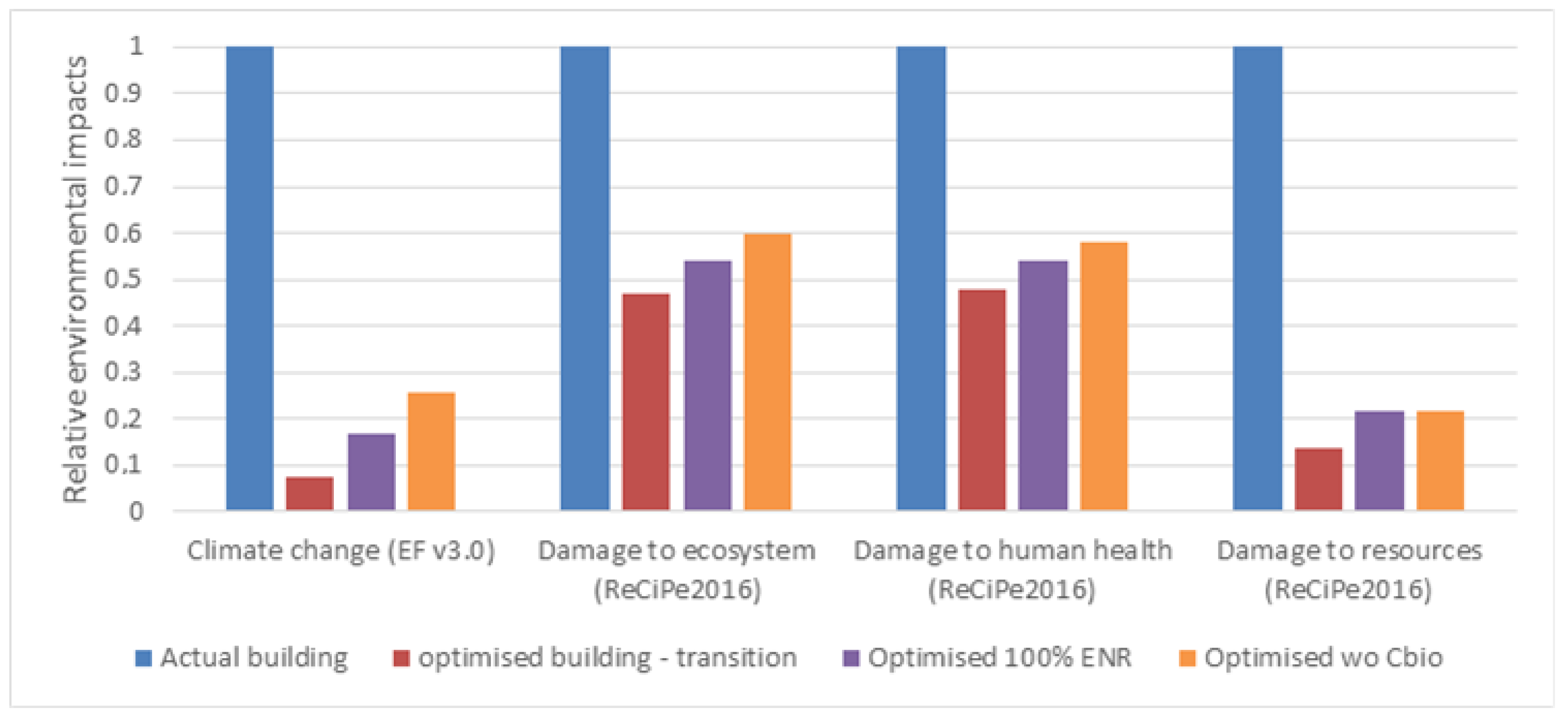
4.4. Circular Economy
4.5. Behavioral Changes
- -
- a radical reduction in the number of newly constructed buildings,
- -
- increasing the density of people occupying buildings,
- -
- accepting higher variability of air temperature indoors (using adaptive thermal comfort models in simulations).
4.6. Prospective Uncertainties
4.7. Temptation of Hasty Electrification
4.8. Generalisation of the Results
5. Conclusions and Perspectives
Author Contributions
Funding
Data Availability Statement
Acknowledgments
Conflicts of Interest
References
- European Parliament, Council of the European Union. EUR-Lex—32010L0031—EN—EUR-Lex. Available online: https://eur-lex.europa.eu/eli/dir/2010/31/oj (accessed on 9 May 2023).
- United Nations Framework Convention on Climate Change. The Paris Agreement. 2015. Available online: https://unfccc.int/sites/default/files/english_paris_agreement.pdf (accessed on 11 May 2023).
- Rockström, J.; Steffen, W.; Noone, K.; Persson, Å.; Chapin, F.S., III; Lambin, E.F.; Lenton, T.M.; Scheffer, M.; Folke, C.; Schellnhuber, H.J.; et al. A safe operating space for humanity. Nature 2009, 461, 472–475. [Google Scholar] [CrossRef]
- Steffen, W.; Richardson, K.; Rockström, J.; Cornell, S.E.; Fetzer, I.; Bennett, E.M.; Biggs, R.; Carpenter, S.R.; De Vries, W.; De Wit, C.A.; et al. Planetary boundaries: Guiding human development on a changing planet. Science 2015, 347, 1259855. [Google Scholar] [CrossRef] [PubMed]
- Richardson, K.; Steffen, W.; Lucht, W.; Bendtsen, J.; Cornell, S.E.; Donges, J.F.; Drüke, M.; Fetzer, I.; Bala, G.; von Bloh, W.; et al. Earth beyond six of nine planetary boundaries. Sci. Adv. 2023, 9, eadh2458. [Google Scholar] [CrossRef] [PubMed]
- Mata, E.; Korpal, A.K.; Cheng, S.H.; Navarro, J.P.J.; Filippidou, F.; Reyna, J.; Wang, R. A map of roadmaps for zero and low energy and carbon buildings worldwide. Environ. Res. Lett. 2020, 15, 113003. [Google Scholar] [CrossRef]
- Huovila, A.; Siikavirta, H.; Rozado, C.A.; Rökman, J.; Tuominen, P.; Paiho, S.; Hedman, A.; Ylén, P. Carbon-neutral cities: Critical review of theory and practice. J. Clean. Prod. 2022, 341, 130912. [Google Scholar] [CrossRef]
- Sartori, I.; Napolitano, A.; Voss, K. Net zero energy buildings: A consistent definition framework. Energy Build. 2012, 48, 220–232. [Google Scholar] [CrossRef]
- Kristjansdottir, T.F.; Heeren, N.; Andresen, I.; Brattebø, H. Comparative emission analysis of low-energy and zero-emission buildings. Build. Res. Inf. 2018, 46, 367–382. [Google Scholar] [CrossRef]
- Lausselet, C.; Borgnes, V.; Brattebø, H. LCA modelling for Zero Emission Neighbourhoods in early stage planning. Build. Environ. 2019, 149, 379–389. [Google Scholar] [CrossRef]
- Brozovsky, J.; Gustavsen, A.; Gaitani, N. Zero emission neighbourhoods and positive energy districts—A state-of-the-art review. Sustain. Cities Soc. 2021, 72, 103013. [Google Scholar] [CrossRef]
- Satola, D.; Balouktsi, M.; Lützkendorf, T.; Wiberg, A.H.; Gustavsen, A. How to define (net) zero greenhouse gas emissions buildings: The results of an international survey as part of IEA EBC annex 72. Build. Environ. 2021, 192, 107619. [Google Scholar] [CrossRef]
- Georges, L.; Haase, M.; Wiberg, A.H.; Kristjansdottir, T.; Risholt, B. Life cycle emissions analysis of two nZEB concepts. Build. Res. Inf. 2015, 43, 82–93. [Google Scholar] [CrossRef]
- Moschetti, R.; Brattebø, H.; Sparrevik, M. Exploring the pathway from zero-energy to zero-emission building solutions: A case study of a Norwegian office building. Energy Build. 2019, 188–189, 84–97. [Google Scholar] [CrossRef]
- Osmani, M.; O’Reilly, A. Feasibility of zero carbon homes in England by 2016: A house builder’s perspective. Build. Environ. 2009, 44, 1917–1924. [Google Scholar] [CrossRef]
- Oltra-Badenes, R.; Guerola-Navarro, V.; Gil-Gómez, J.-A.; Botella-Carrubi, D. Design and Implementation of Teaching–Learning Activities Focused on Improving the Knowledge, the Awareness and the Perception of the Relationship between the SDGs and the Future Profession of University Students. Sustainability 2023, 15, 5324. [Google Scholar] [CrossRef]
- Ahmed, N. Developing a tailored tool to assess regenerative development and design within the built environment. J. Green Build. 2023, 18, 135–166. [Google Scholar] [CrossRef]
- Sharma, A.; Saxena, A.; Sethi, M.; Shree, V. Varun Life cycle assessment of buildings: A review. Renew. Sustain. Energy Rev. 2011, 15, 871–875. [Google Scholar] [CrossRef]
- Cabeza, L.F.; Rincón, L.; Vilariño, V.; Pérez, G.; Castell, A. Life cycle assessment (LCA) and life cycle energy analysis (LCEA) of buildings and the building sector: A review. Renew. Sustain. Energy Rev. 2014, 29, 394–416. [Google Scholar] [CrossRef]
- Anand, C.K.; Amor, B. Recent developments, future challenges and new research directions in LCA of buildings: A critical review. Renew. Sustain. Energy Rev. 2017, 67, 408–416. [Google Scholar] [CrossRef]
- Hansen, R.N.; Rasmussen, F.N.; Ryberg, M.; Birgisdóttir, H. A systematic review of consequential LCA on buildings: The perspectives and challenges of applications and inventory modelling. Int. J. Life Cycle Assess. 2022, 28, 131–145. [Google Scholar] [CrossRef]
- Frischknecht, R.; Benetto, E.; Dandres, T.; Heijungs, R.; Roux, C.; Schrijvers, D.; Wernet, G.; Yang, Y.; Messmer, A.; Tschuemperlin, L. LCA and decision making: When and how to use consequential LCA; 62nd LCA forum, Swiss Federal Institute of Technology, Zürich, 9 September 2016. Int. J. Life Cycle Assess. 2016, 22, 296–301. [Google Scholar] [CrossRef]
- Andersen, C.E.; Ohms, P.; Rasmussen, F.N.; Birgisdóttir, H.; Birkved, M.; Hauschild, M.; Ryberg, M. Assessment of absolute environmental sustainability in the built environment. Build. Environ. 2020, 171, 106633. [Google Scholar] [CrossRef]
- Bjoern, A.; Chandrakumar, C.; Boulay, A.-M.; Doka, G.; Fang, K.; Gondran, N.; Hauschild, M.Z.; Kerkhof, A.; King, H.; Margni, M.; et al. Review of life-cycle based methods for absolute environmental sustainability assessment and their applications. Environ. Res. Lett. 2020, 15, 083001. [Google Scholar] [CrossRef]
- Brejnrod, K.N.; Kalbar, P.; Petersen, S.; Birkved, M. The absolute environmental performance of buildings. Build. Environ. 2017, 119, 87–98. [Google Scholar] [CrossRef]
- Ramage, M.H.; Burridge, H.; Busse-Wicher, M.; Fereday, G.; Reynolds, T.; Shah, D.U.; Wu, G.; Yu, L.; Fleming, P.; Densley-Tingley, D.; et al. The wood from the trees: The use of timber in construction. Renew. Sustain. Energy Rev. 2017, 68, 333–359. [Google Scholar] [CrossRef]
- Carcassi, O.B.; Habert, G.; Malighetti, L.E.; Pittau, F. Material Diets for Climate-Neutral Construction. Environ. Sci. Technol. 2022, 56, 5213–5223. [Google Scholar] [CrossRef] [PubMed]
- Dahiya, S.; Katakojwala, R.; Ramakrishna, S.; Venkata Mohan, S. Biobased products and life cycle assessment in the context of circular economy and sustainability. Mat. Circ. Econ. 2020, 2, 7. [Google Scholar] [CrossRef]
- Matthews, R.; Sokka, L.; Soimakallio, S.; Mortimer, N.; Rix, J.; Schelhaas, M.; Jenkins, T.; Hogan, G.; Mackie, E.; Morris, A.; et al. Review of Literature on Biogenic Carbon and Life Cycle Assessment of Forest Bioenergy. Forest Research. 2014. Available online: http://www.energy-wsp.org/media/upload/veipraktiki34.pdf (accessed on 3 November 2015).
- Hoxha, E.; Passer, A.; Saade, M.R.M.; Trigaux, D.; Shuttleworth, A.; Pittau, F.; Allacker, K.; Habert, G. Biogenic carbon in buildings: A critical overview of LCA methods. Build. Cities 2020, 1, 504–524. [Google Scholar] [CrossRef]
- Andersen, C.E.; Rasmussen, F.N.; Habert, G.; Birgisdóttir, H. Embodied GHG Emissions of Wooden Buildings—Challenges of Biogenic Carbon Accounting in Current LCA Methods. Front. Built Environ. 2021, 7, 120. [Google Scholar] [CrossRef]
- Tellnes, L.; Ganne-Chedeville, C.; Dias, A.; Dolezal, F.; Hill, C.; Escamilla, E.Z. Comparative assessment for biogenic carbon accounting methods in carbon footprint of products: A review study for construction materials based on forest products. iForest Biogeosci. For. 2017, 10, 815–823. [Google Scholar] [CrossRef]
- Cherubini, F.; Guest, G.; Strømman, A.H. Application of probability distributions to the modeling of biogenic CO2 fluxes in life cycle assessment. GCB Bioenergy 2012, 4, 784–798. [Google Scholar] [CrossRef]
- Head, M.; Bernier, P.; Levasseur, A.; Beauregard, R.; Margni, M. Forestry carbon budget models to improve biogenic carbon accounting in life cycle assessment. J. Clean. Prod. 2019, 213, 289–299. [Google Scholar] [CrossRef]
- Seymour, F. Seeing the Forests as well as the (Trillion) Trees in Corporate Climate Strategies. One Earth 2020, 2, 390–393. [Google Scholar] [CrossRef]
- Habert, G.; Miller, S.A.; John, V.M.; Provis, J.L.; Favier, A.; Horvath, A.; Scrivener, K.L. Environmental impacts and decarbonization strategies in the cement and concrete industries. Nat. Rev. Earth Environ. 2020, 1, 559–573. [Google Scholar] [CrossRef]
- Liu, X.; Peng, R.; Bai, C.; Chi, Y.; Li, H.; Guo, P. Technological roadmap towards optimal decarbonization development of China’s iron and steel industry. Sci. Total Environ. 2022, 850, 157701. [Google Scholar] [CrossRef] [PubMed]
- Tautorat, P.; Lalin, B.; Schmidt, T.S.; Steffen, B. Directions of innovation for the decarbonization of cement and steel production—A topic modeling-based analysis. J. Clean. Prod. 2023, 407, 137055. [Google Scholar] [CrossRef]
- Chai, S.Y.W.; Ngu, L.H.; How, B.S.; Chin, M.Y.; Abdouka, K.; Adini, M.J.B.A.; Kassim, A.M. Review of CO2 capture in construction-related industry and their utilization. Int. J. Greenh. Gas Control. 2022, 119, 103727. [Google Scholar] [CrossRef]
- Peuportier, B.; Sommereux, I.B. Simulation tool with its expert interface for the thermal design of multizone buildings. Int. J. Sol. Energy 1990, 8, 109–120. [Google Scholar] [CrossRef]
- Munaretto, F.; Recht, T.; Schalbart, P.; Peuportier, B. Empirical validation of different internal superficial heat transfer models on a full-scale passive house. J. Build. Perform. Simul. 2018, 11, 261–282. [Google Scholar] [CrossRef]
- Judkoff, R.; Neymark, J. International Energy Agency Building Energy Simulation Test (BESTEST) and Diagnostic Method; NREL/TP-472-6231; National Renewable Energy Lab. (NREL): Golden, CO, USA, 1995. [CrossRef]
- Judkoff, R.; Neymark, J. Twenty Years On!: Updating the IEA BESTEST Building Thermal Fabric Test Cases for ASHRAE Standard 140. In Proceedings of the BS 2013: 13th Conference of the International Building Performance Simulation Association, Chambery, France, 26–28 August 2013; pp. 63–70. [Google Scholar]
- ISO 14040:2006; Environmental Management—Life Cycle Assessment—Principles and Framework. ISO: Geneva, Switzerland, 2006.
- ISO 14044:2006; Environmental Management—Life Cycle Assessment—Requirements and Guidelines. ISO: Geneva, Switzerland, 2006.
- Mutel, C. Brightway: An open source framework for Life Cycle Assessment. J. Open Source Softw. 2017, 2, 236. [Google Scholar] [CrossRef]
- Frischknecht, R.; Jungbluth, N.; Althaus, H.-J.; Doka, G.; Dones, R.; Heck, T.; Hellweg, S.; Hischier, R.; Nemecek, T.; Rebitzer, G.; et al. Overview and Methodology. Ecoinvent. Rep. 2007. Available online: http://www.ecoinvent.org/fileadmin/documents/en/01_OverviewAndMethodology.pdf (accessed on 20 June 2013).
- Wernet, G.; Bauer, C.; Steubing, B.; Reinhard, J.; Moreno-Ruiz, E.; Weidema, B. The ecoinvent database version 3 (part I): Overview and methodology. Int. J. Life Cycle Assess. 2016, 21, 1218–1230. [Google Scholar] [CrossRef]
- Frapin, M.; Roux, C.; Assoumou, E.; Peuportier, B. Modelling long-term and short-term temporal variation and uncertainty of electricity production in the life cycle assessment of buildings. Appl. Energy 2021, 307, 118141. [Google Scholar] [CrossRef]
- European Commission, Joint Research Centre. Environmental Footprint: Update of Life Cycle Impact Assessment Methods: Ecotoxicity Freshwater, Human Toxicity Cancer, and Non Cancer; Publications Office of the European Union: Luxembourg, 2020; Available online: https://data.europa.eu/doi/10.2760/300987 (accessed on 3 September 2021).
- Huijbregts, M.A.J.; Steinmann, Z.J.N.; Elshout, P.M.F.; Stam, G.; Verones, F.; Vieira, M.; Zijp, M.; Hollander, A.; van Zelm, R. ReCiPe2016: A harmonised life cycle impact assessment method at midpoint and endpoint level. Int. J. Life Cycle Assess. 2017, 22, 138–147. [Google Scholar] [CrossRef]
- EN 15804+A2; Sustainability of Construction Works—Environmental Product Declarations—Core Rules for the Product Category of Construction Products. EU: Brussels, Belgium, 2019.
- Levasseur, A.; Lesage, P.; Margni, M.; Samson, R. Biogenic Carbon and Temporary Storage Addressed with Dynamic Life Cycle Assessment. J. Ind. Ecol. 2013, 17, 117–128. [Google Scholar] [CrossRef]
- Vorger, E.; Schalbart, P.; Peuportier, B. Integration of a comprehensive stochastic model of occupancy in building simulation to study how inhabitants influence energy performance. In Proceedings of the 30th International PLEA 2014 Conference, Ahmedabad, India, 16–18 December 2014; p. 8. [Google Scholar]
- Wurtz, A.; Peuportier, B. Application of the Life Cycle Assessment to a Building Sample for in Order to Helping in Projects Evaluation. In Proceedings of the Climamed Conference, Lisbon, Portugal, 11 May 2021; Available online: https://hal.archives-ouvertes.fr/hal-03194021 (accessed on 8 March 2022).
- ADEME. Mix électrique 100% Renouvelable? Analyses et Optimisations. 2016. Available online: https://librairie.ademe.fr/cadic/2889/mix-electrique-rapport-2015.pdf (accessed on 14 June 2023).
- Pulselli, R.M.; Saladini, F.; Neri, E.; Bastianoni, S. A comprehensive lifecycle evaluation of vertical greenery systems based on systemic indicators. In Proceedings of the Sustainable City 2014, 9th International Conference on Urban Regeneration and Sustainability is a Civil Engineering, Siena, Italy, 23–25 September 2014; pp. 1017–1024. [Google Scholar]
- Marchi, M.; Pulselli, R.M.; Marchettini, N.; Pulselli, F.M.; Bastianoni, S. Carbon dioxide sequestration model of a vertical greenery system. Ecol. Model. 2015, 306, 46–56. [Google Scholar] [CrossRef]
- Rowe, T.; Poppe, J.; Buyle, M.; Belmans, B.; Audenaert, A. Is the sustainability potential of vertical greening systems deeply rooted? Establishing uniform outlines for environmental impact assessment of VGS. Renew. Sustain. Energy Rev. 2022, 162, 112414. [Google Scholar] [CrossRef]
- Lelarge, K.; Birot, J. Etude de la Séquestration de Carbone Par Les éCosystèmes de la Réserve Naturelle du Pinail; GEREPI: Vouneuil-sur-Vienne, France, 2021; 26p. [Google Scholar]
- IFN, Inventaire Forestier National (IFN). La Forêt Française: Un Puit de Carbone? Son Role Dans la Limitations des Changements Climatiques. 2005. Available online: https://inventaire-forestier.ign.fr/IMG/pdf/L_IF_no07_carbone.pdf (accessed on 11 May 2023).
- French Data and Statistical Studies Department (SDES). Key Figures on Housing—2022 Edition. 2022. Available online: https://www.statistiques.developpement-durable.gouv.fr/edition-numerique/chiffres-cles-du-logement-2022/pdf/Chiffres-cles-logement-2022.pdf (accessed on 28 June 2023). (In French)
- French Ministry of Agriculture and Food Security. Forest—Wood. Ministère de l’Agriculture et de la Souveraineté Alimentaire. Available online: https://agriculture.gouv.fr/foret-bois (accessed on 28 June 2023). (In French)
- Huuskonen, S.; Domisch, T.; Finér, L.; Hantula, J.; Hynynen, J.; Matala, J.; Miina, J.; Neuvonen, S.; Nevalainen, S.; Niemistö, P.; et al. What is the potential for replacing monocultures with mixed-species stands to enhance ecosystem services in boreal forests in Fennoscandia? For. Ecol. Manag. 2021, 479, 118558. [Google Scholar] [CrossRef]
- Lindner, M.; Maroschek, M.; Netherer, S.; Kremer, A.; Barbati, A.; Garcia-Gonzalo, J.; Seidl, R.; Delzon, S.; Corona, P.; Kolström, M.; et al. Climate change impacts, adaptive capacity, and vulnerability of European forest ecosystems. For. Ecol. Manag. 2010, 259, 698–709. [Google Scholar] [CrossRef]
- Hoxha, E.; Maierhofer, D.; Saade, M.; Passer, A. Influence of technical and electrical equipment in life cycle assessments of buildings: Case of a laboratory and research building. Int. J. Life Cycle Assess. 2021, 26, 852–863. [Google Scholar] [CrossRef]
- Polster, B.; Peuportier, B.; Sommereux, I.B.; Pedregal, P.D.; Gobin, C.; Durand, E. Evaluation of the environmental quality of buildings towards a more environmentally conscious design. Sol. Energy 1996, 57, 219–230. [Google Scholar] [CrossRef]
- French Ministry of Ecological Transition and Territorial Cohesion. Reporting on French Low Carbon Strategy. 2021. Available online: https://www.ecologie.gouv.fr/sites/default/files/2021_Indicateurs%20de%20r%C3%A9sultats_SNBC-vF.pdf (accessed on 28 June 2023). (In French)
- Hertwich, E. Understanding the Climate Mitigation Benefits of Product Systems: Comment on “Using Attributional Life Cycle Assessment to Estimate Climate-Change Mitigation…”. J. Ind. Ecol. 2014, 18, 464–465. [Google Scholar] [CrossRef]
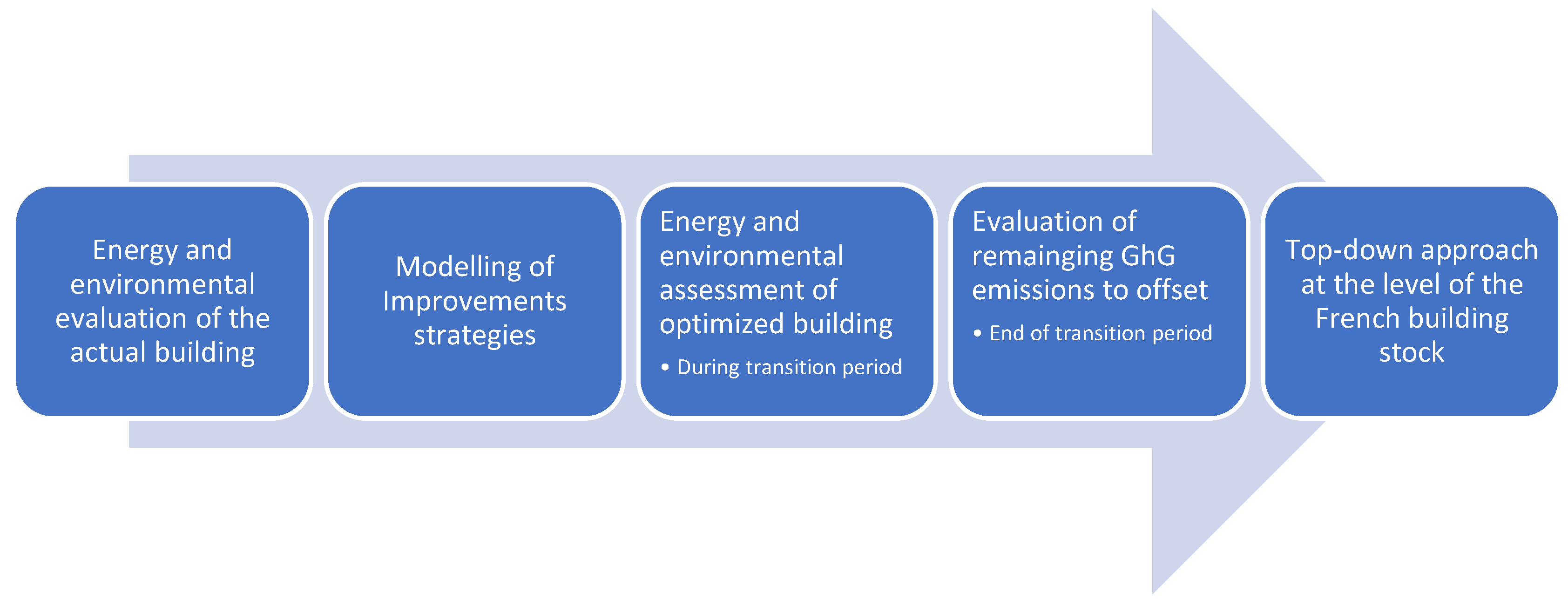
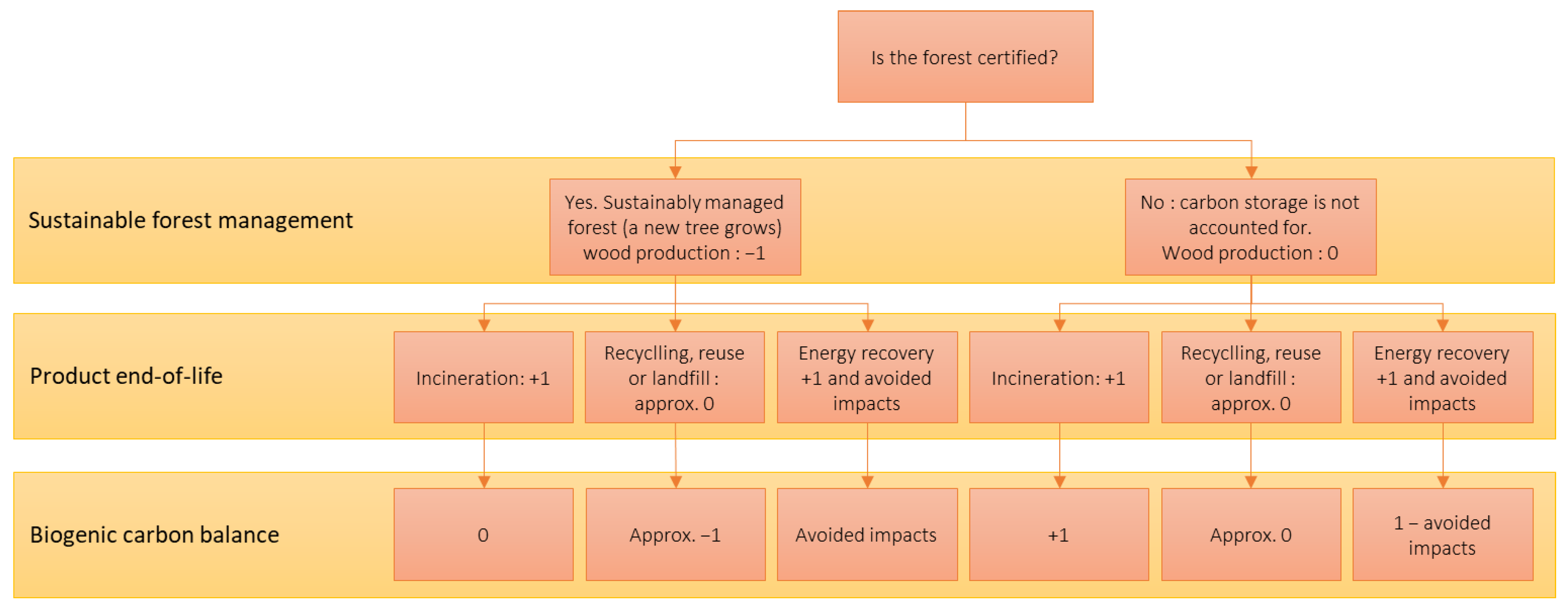
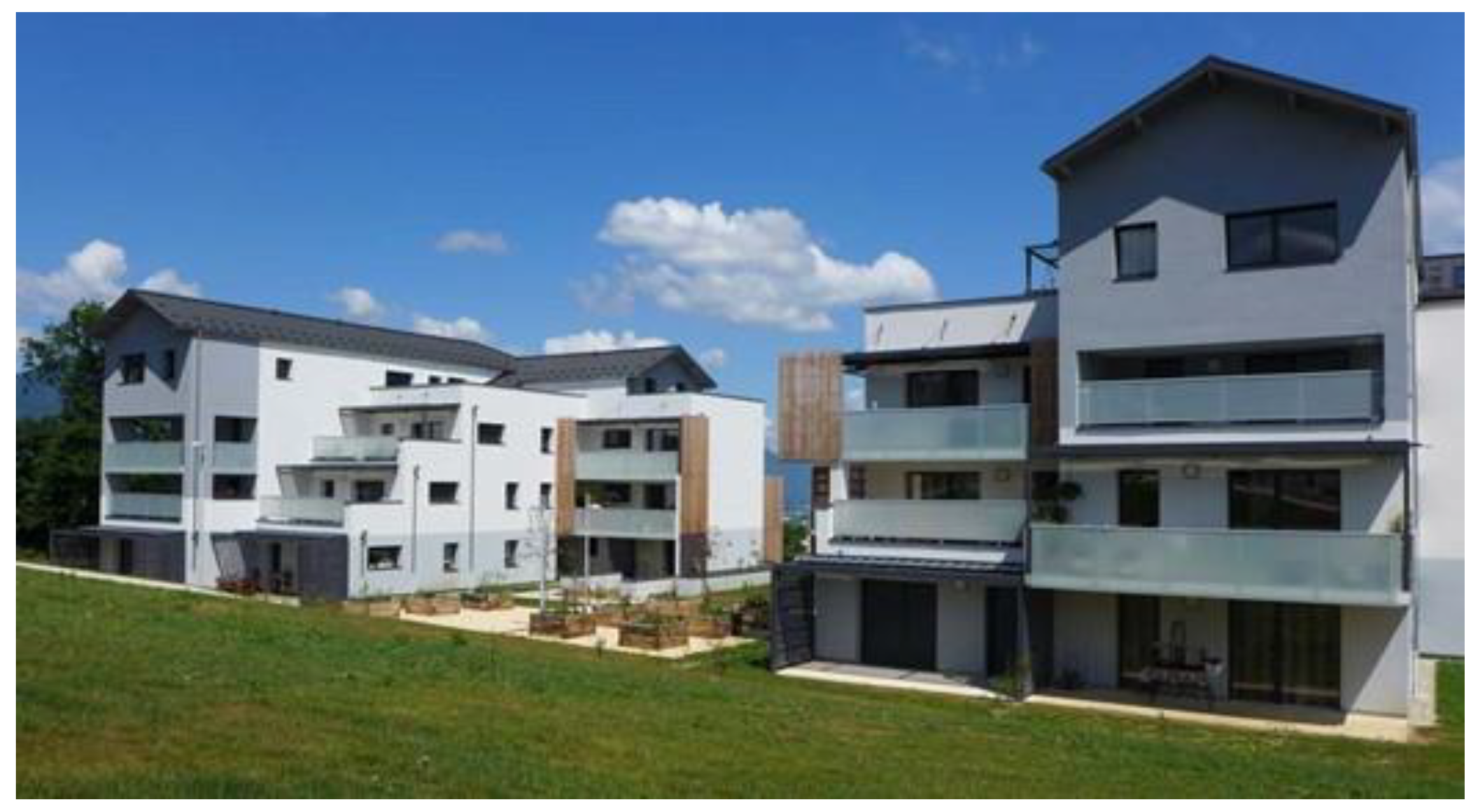

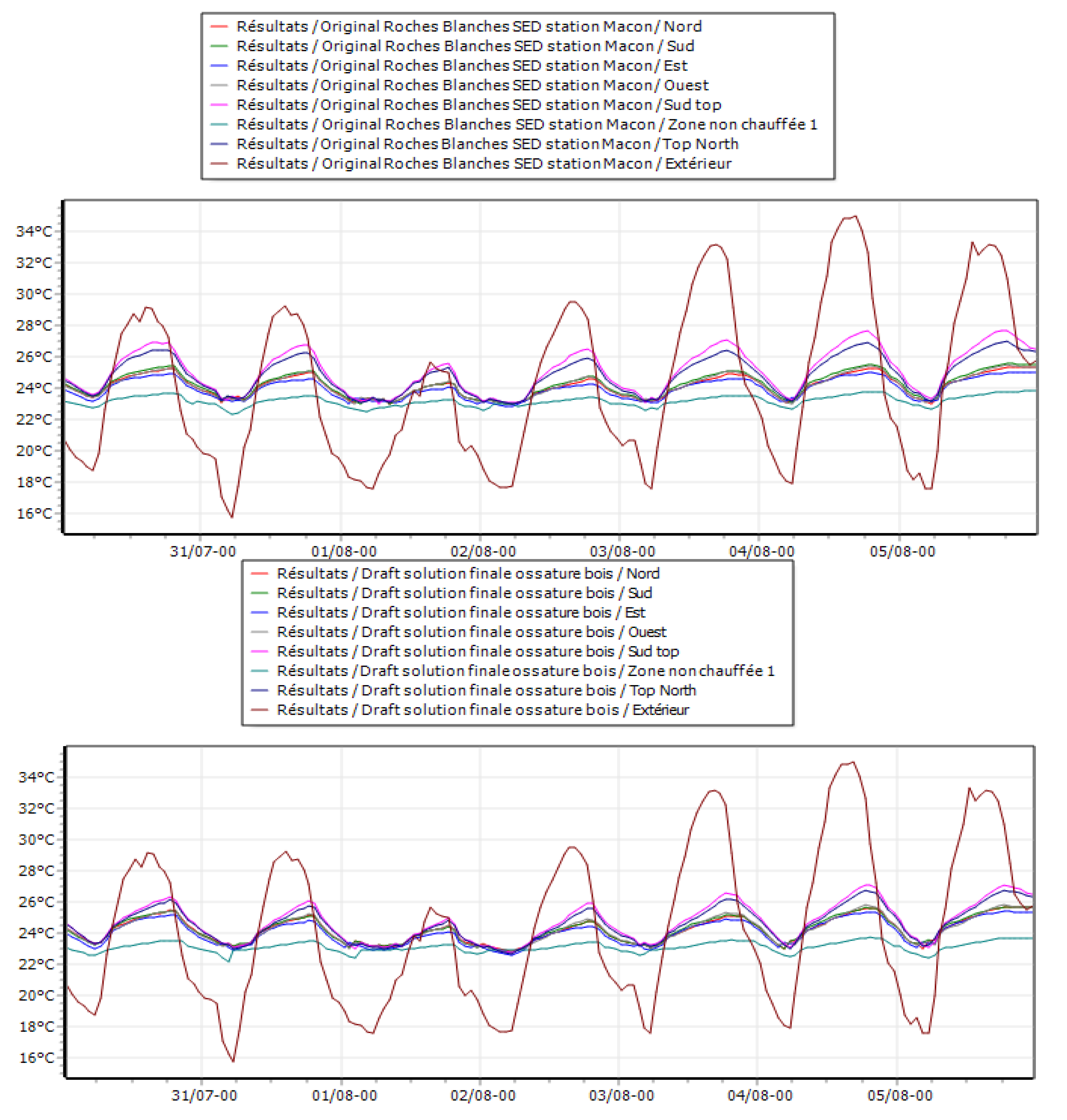
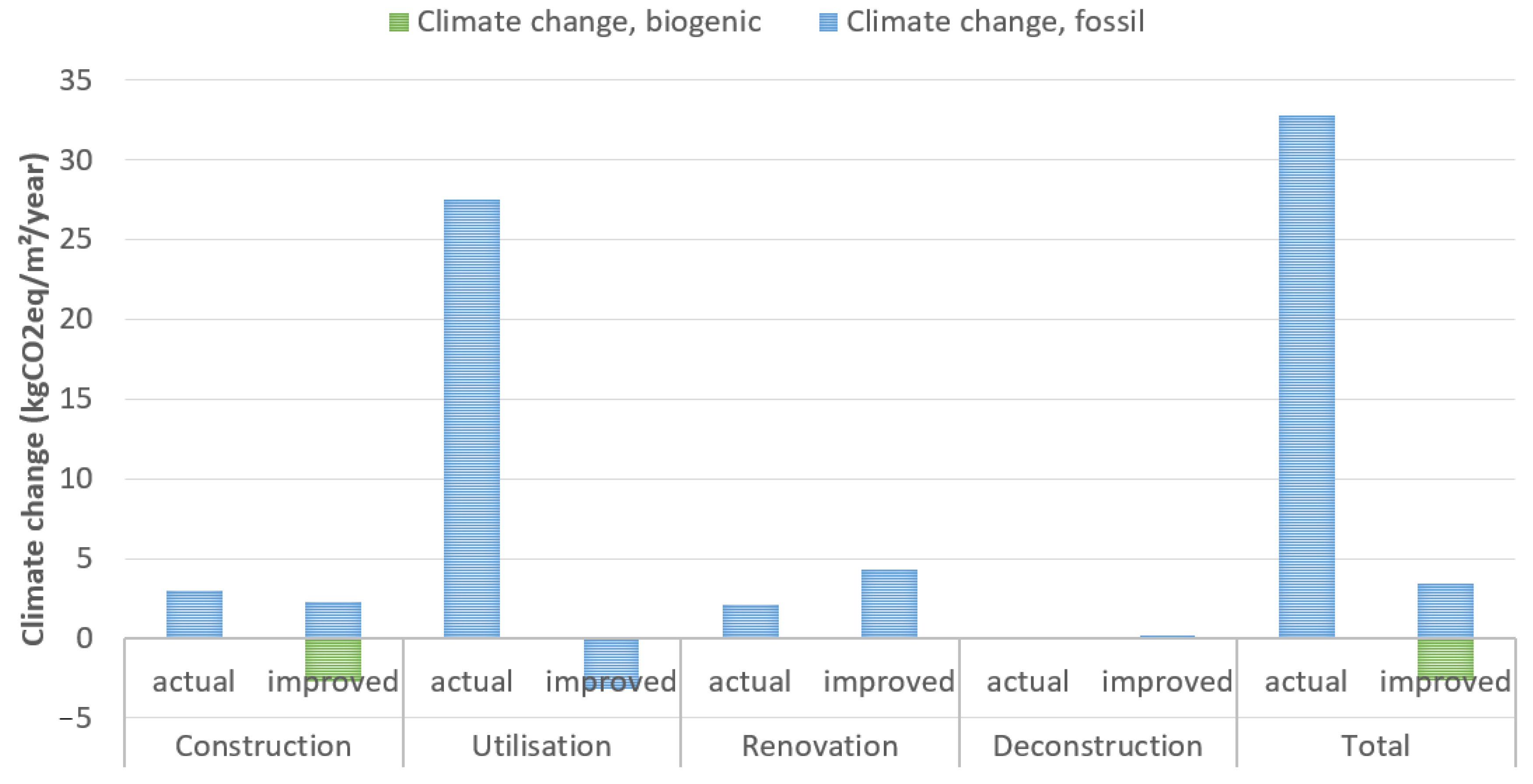
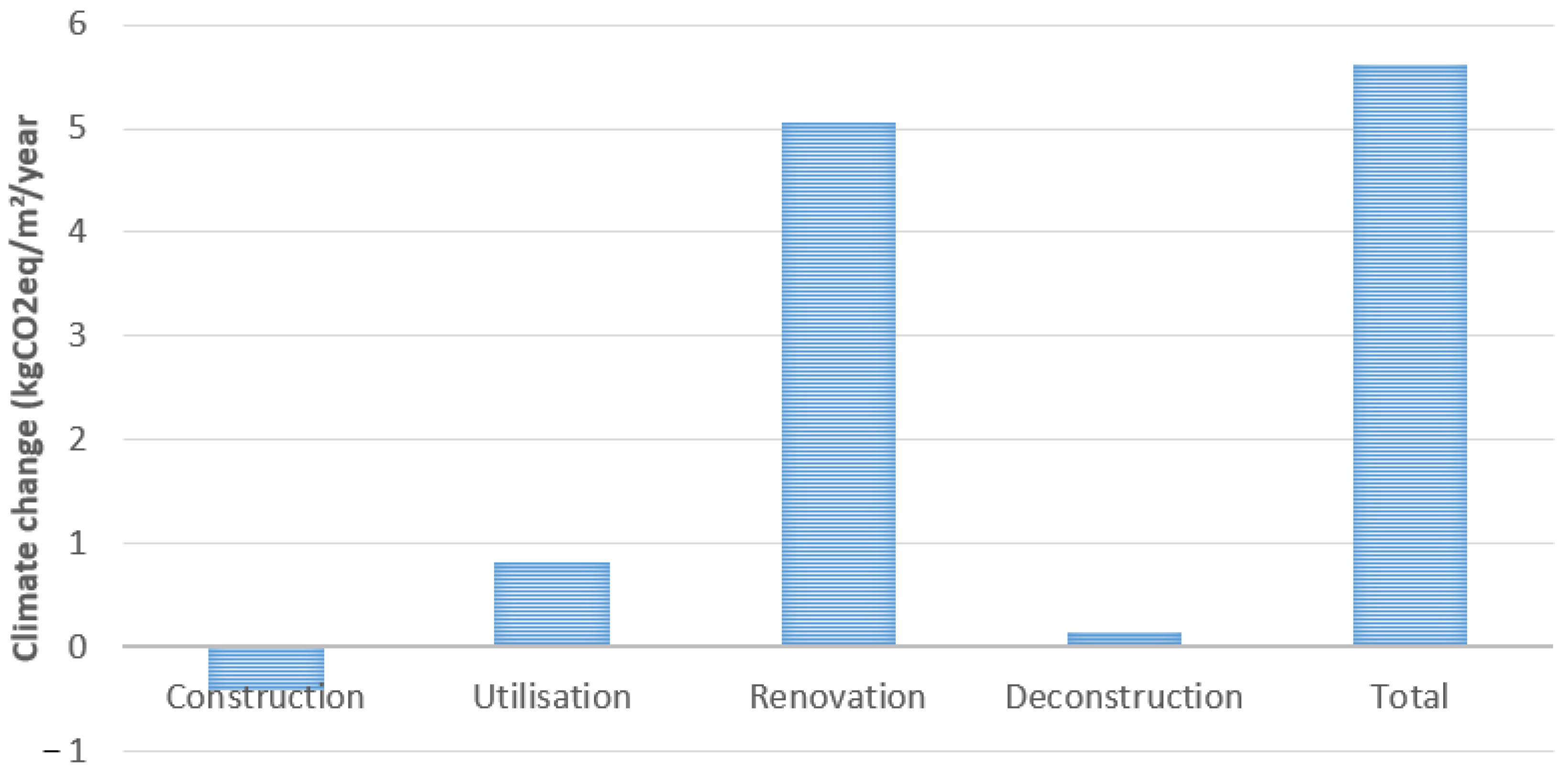
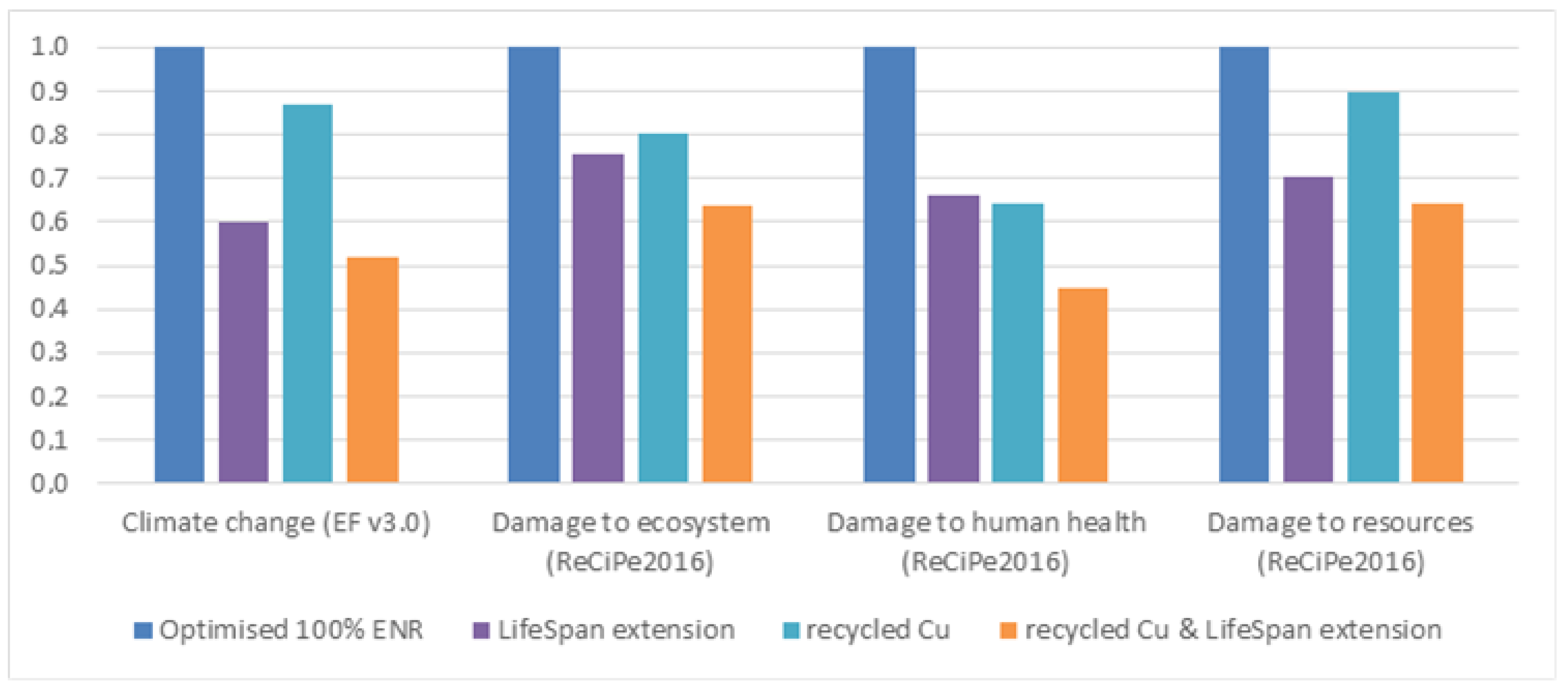
| Category | Equipment | Areal Ratio (kWh/m2) |
|---|---|---|
| Heating needs | Gas | 15 |
| Energy needed for DHW | Gas | 34 |
| Electricity use | Grid | 26 |
| Electricity use for ventilation | CMV 1 | 1 |
| Impact | Unit | Construction | Use | Renovation | End-of-Life | Total |
|---|---|---|---|---|---|---|
| Climate change (EF v3.0) | kgCO2 eq/m2/yr | 3.1 × 100 | 2.7 × 101 | 2.5 × 100 | 1.2 × 10−1 | 3.3 × 10−1 |
| Damage to ecosystem (ReCiPe2016) | specie.yr/m2/yr | 1.6 × 10−8 | 1.0 × 10−7 | 2.5 × 10−8 | 4.7 × 10−10 | 1.4 × 10−7 |
| Damage to human health (ReCiPe2016) | DALY/m2/yr | 8.7 × 10−6 | 3.9 × 10−5 | 1.8 × 10−5 | 1.7 × 10−7 | 6.7 × 10−5 |
| Damage to resources (ReCiPe2016) | USB/m2/yr | 2.0 × 10−1 | 2.8 × 100 | 2.8 × 10−1 | 8.5 × 10−3 | 3.3 × 100 |
| Category | Equipment | Areal Ratio (kWh/m2) |
|---|---|---|
| Heating needs | Heat pump 30 kW | 5 |
| Energy needed for DHW | solar thermal collector (140 m2) + electric back-up | 13 |
| Electricity use | Network | 26 |
| Electricity consumption for ventilation | CMV | 1 |
| Photovoltaic electricity production | PV panels | 58 |
| Impact | Unit | Construction | Use | Renovation | End-of-Life | Total |
|---|---|---|---|---|---|---|
| Climate change (EF v3.0) | kgCO2 eq/m2/yr | −4.09 × 10−1 | −2.27 × 100 | 5.06 × 100 | 1.49 × 10−1 | 2.53 × 100 |
| Damage to ecosystem (ReCiPe2016) | specie.yr/m2/yr | 2.63 × 10−8 | −8.42 × 10−10 | 3.97 × 10−8 | 5.43 × 10−10 | 6.57 × 10−8 |
| Damage to human health (ReCiPe2016) | DALY/m2/yr | 6.32 × 10−6 | −9.42 × 10−7 | 2.65 × 10−5 | 1.82 × 10−7 | 3.20 × 10−5 |
| Damage to resources (ReCiPe2016) | USB/m2/yr | 1.94 × 10−1 | −2.18 × 10−1 | 4.63 × 10−1 | 7.23 × 10−3 | 4.46 × 10−1 |
Disclaimer/Publisher’s Note: The statements, opinions and data contained in all publications are solely those of the individual author(s) and contributor(s) and not of MDPI and/or the editor(s). MDPI and/or the editor(s) disclaim responsibility for any injury to people or property resulting from any ideas, methods, instructions or products referred to in the content. |
© 2023 by the authors. Licensee MDPI, Basel, Switzerland. This article is an open access article distributed under the terms and conditions of the Creative Commons Attribution (CC BY) license (https://creativecommons.org/licenses/by/4.0/).
Share and Cite
Dicko, A.H.; Roux, C.; Peuportier, B. Achieving Net Zero Carbon Performance in a French Apartment Building? Energies 2023, 16, 7608. https://doi.org/10.3390/en16227608
Dicko AH, Roux C, Peuportier B. Achieving Net Zero Carbon Performance in a French Apartment Building? Energies. 2023; 16(22):7608. https://doi.org/10.3390/en16227608
Chicago/Turabian StyleDicko, Alpha Hamid, Charlotte Roux, and Bruno Peuportier. 2023. "Achieving Net Zero Carbon Performance in a French Apartment Building?" Energies 16, no. 22: 7608. https://doi.org/10.3390/en16227608
APA StyleDicko, A. H., Roux, C., & Peuportier, B. (2023). Achieving Net Zero Carbon Performance in a French Apartment Building? Energies, 16(22), 7608. https://doi.org/10.3390/en16227608







